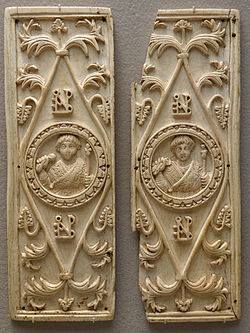
Back Консульскія дыптыхі Byelorussian Konsulardiptykon Danish Konsulardiptychon German Díptico consular Spanish Diptyque consulaire French Diptychon consulare Latin Konsulinis diptikas Lithuanian Consulaire diptiek Dutch Консульские диптихи Russian Konzulski diptih Slovenian

In Late Antiquity, a consular diptych was a type of diptych intended as a de-luxe commemorative object. The diptychs were generally in ivory, wood or metal and decorated with rich relief sculpture. A consular diptych was commissioned by a consul ordinarius to mark his entry to that post, and was distributed as a commemorative reward to those who had supported his candidature or might support him in the future.[1]
- ^ p178. The origin, context, and function of consular diptychs. Alan Cameron, in memory of Tally Kampen. Journal of Roman Studies 103 (2013) pp. 174–207.